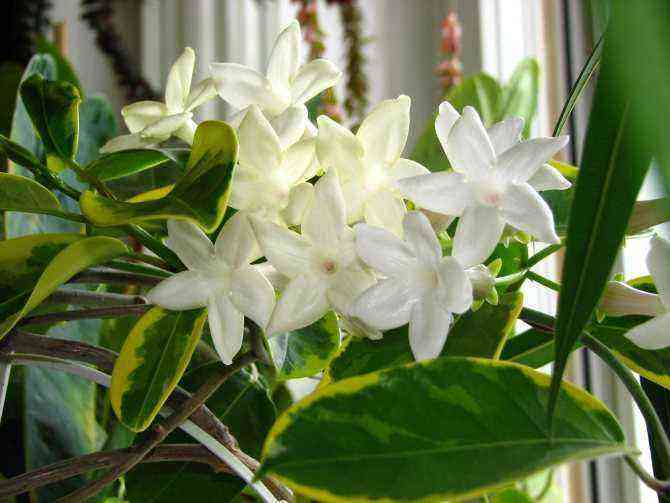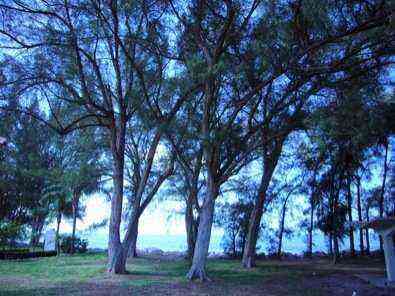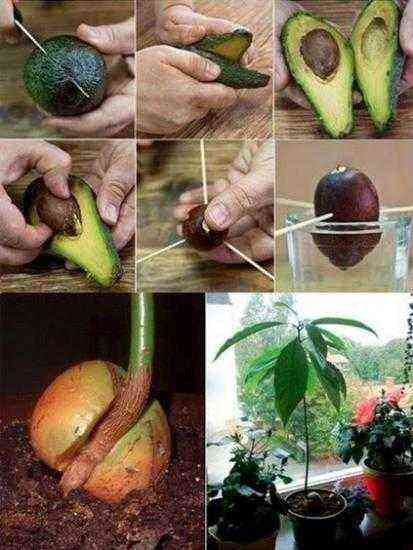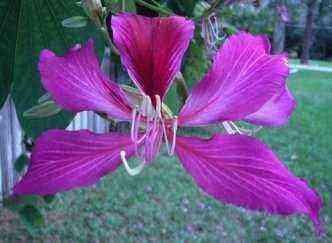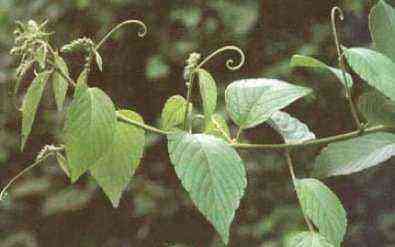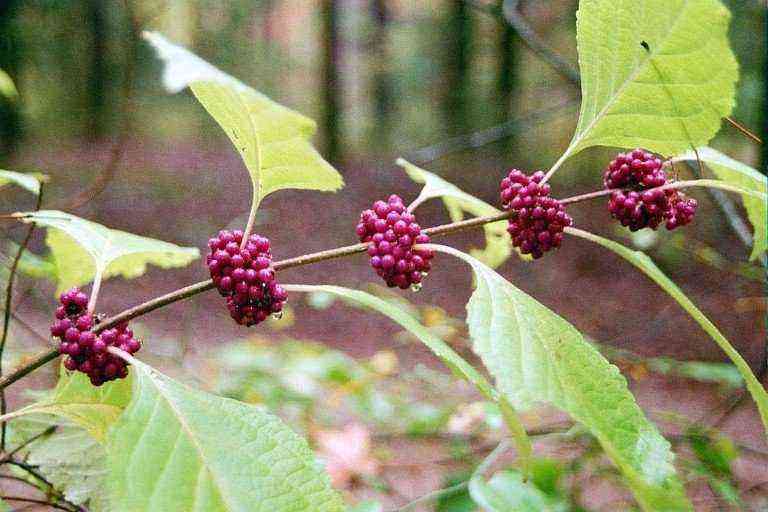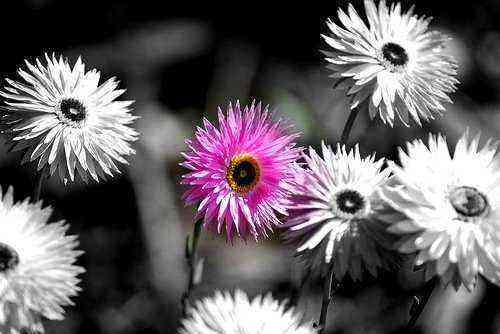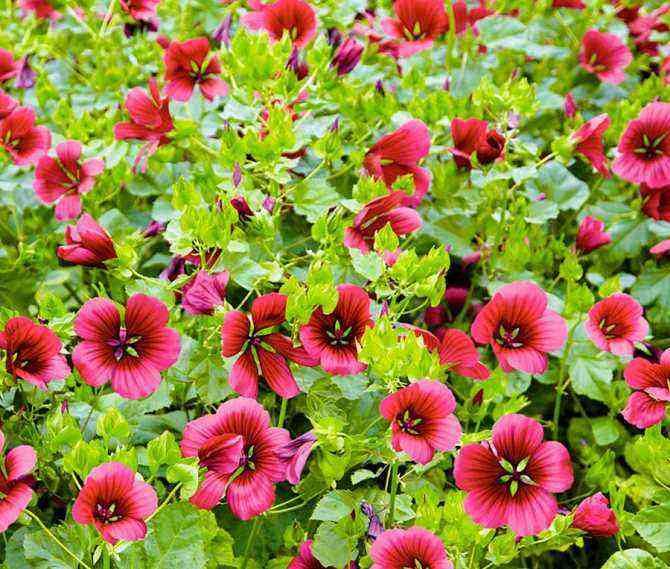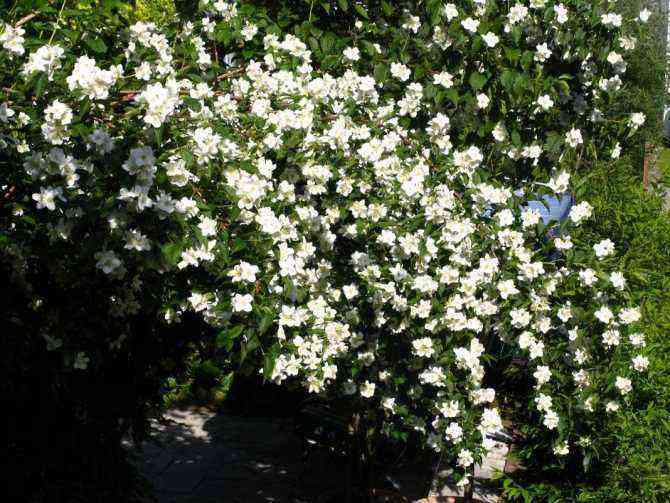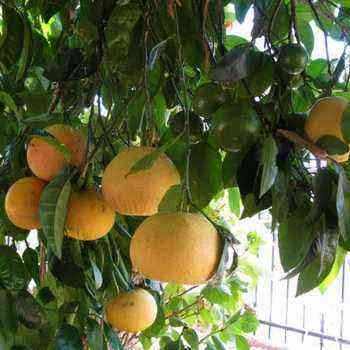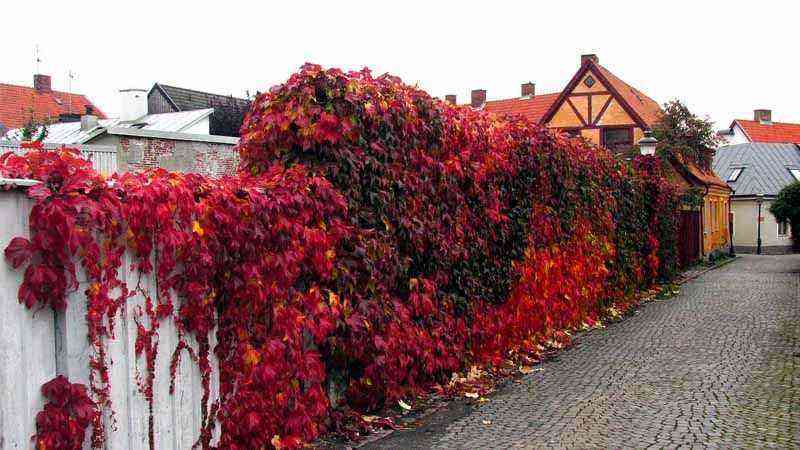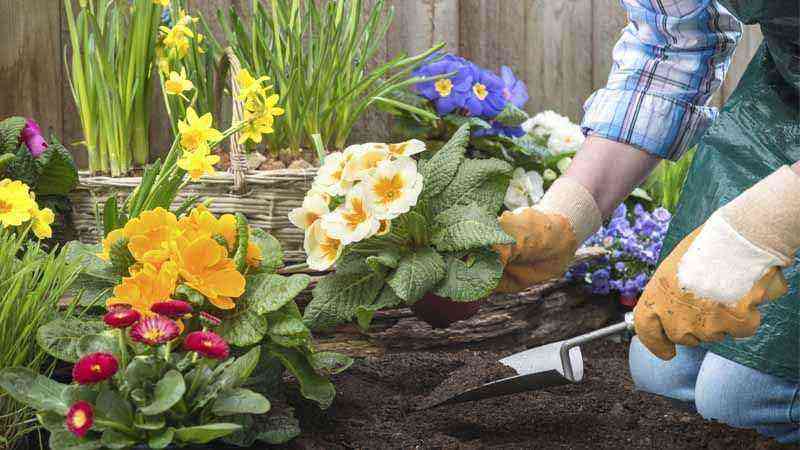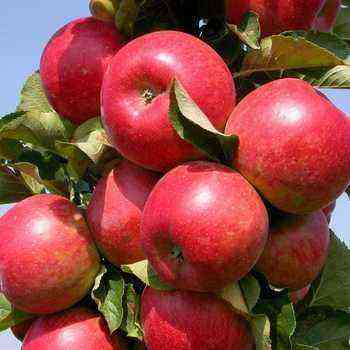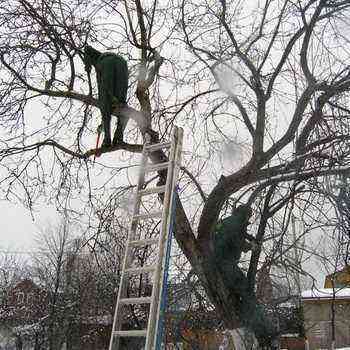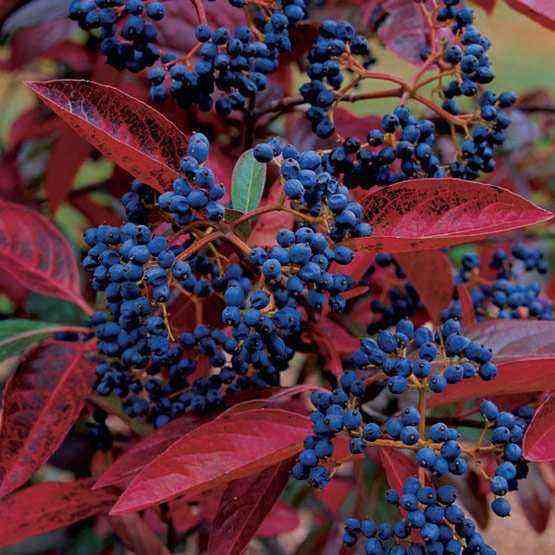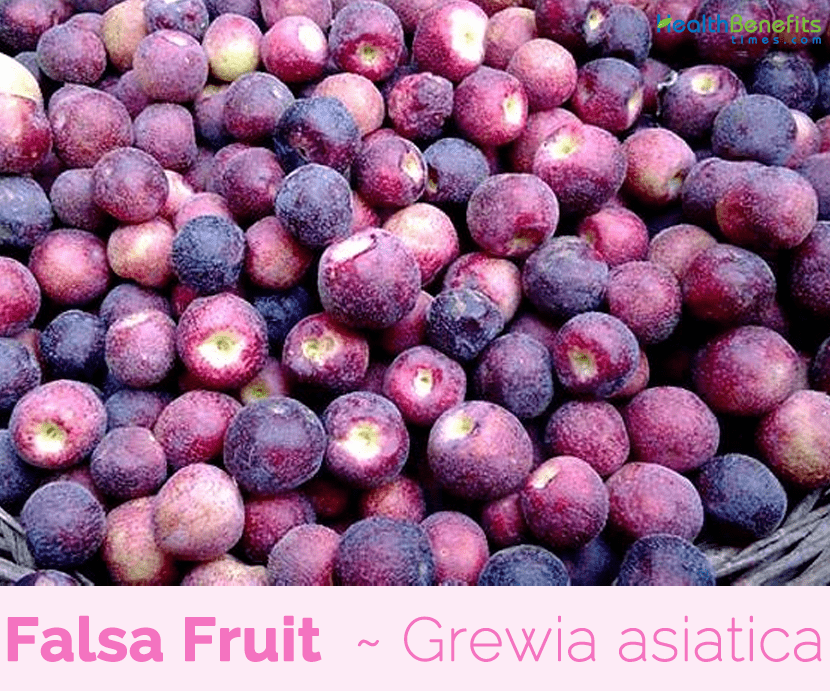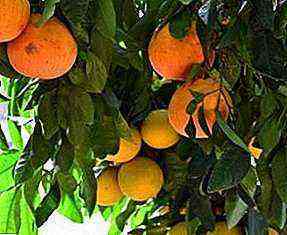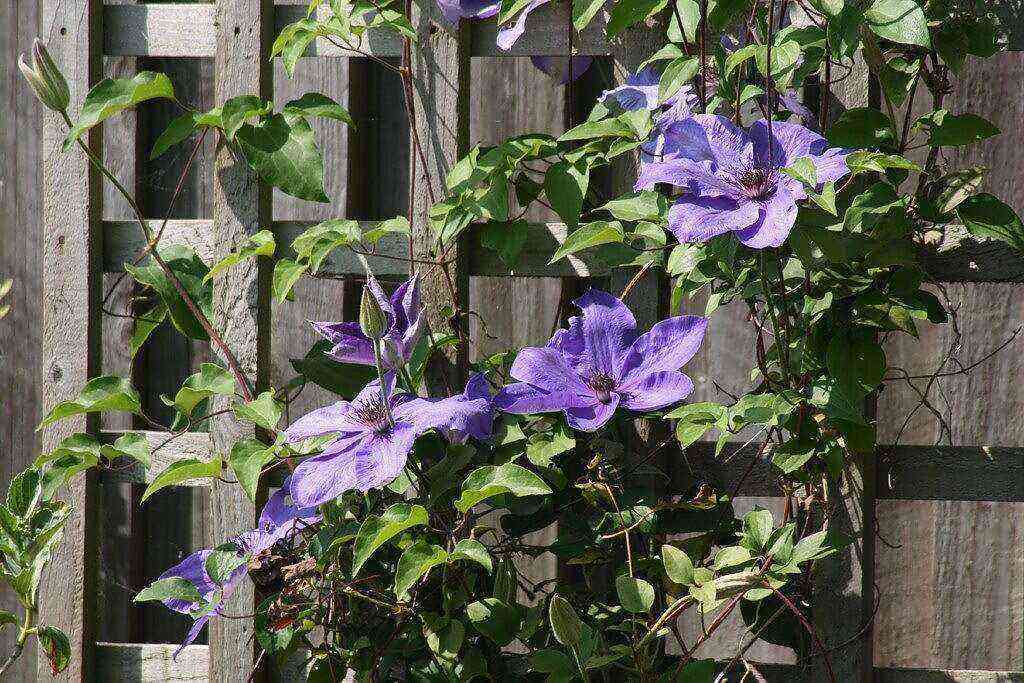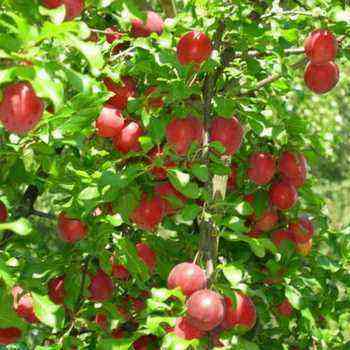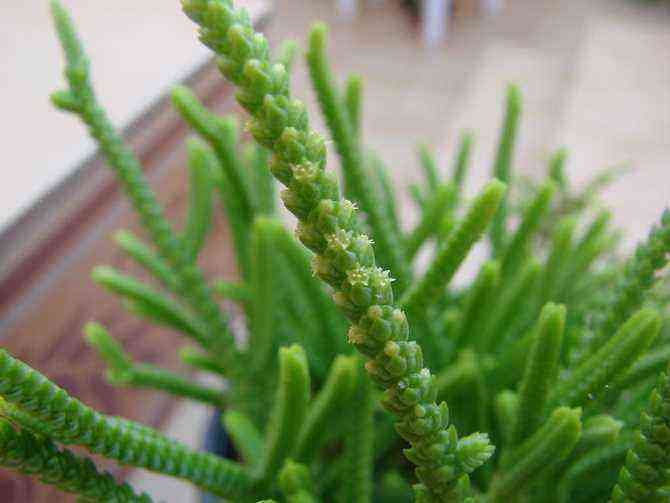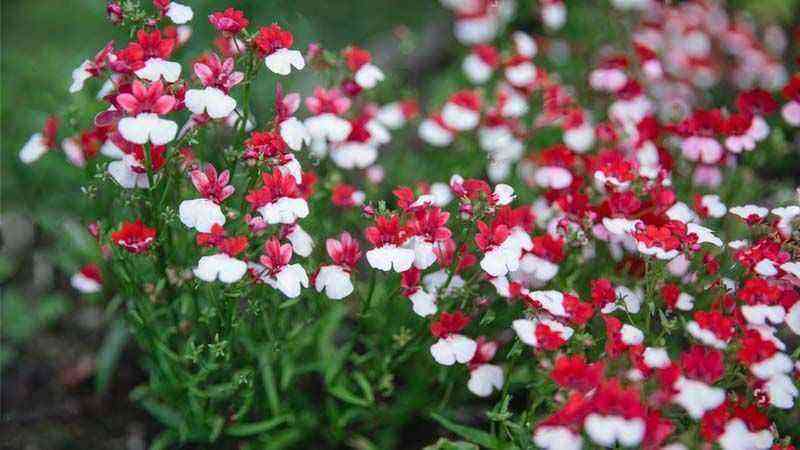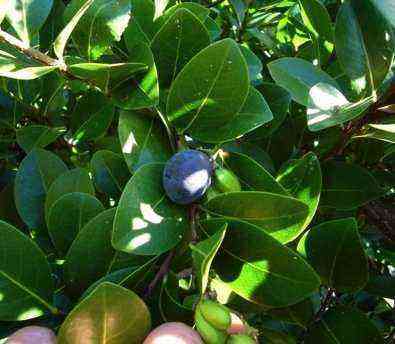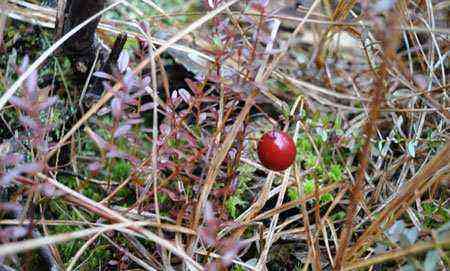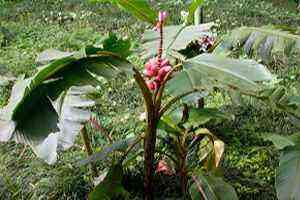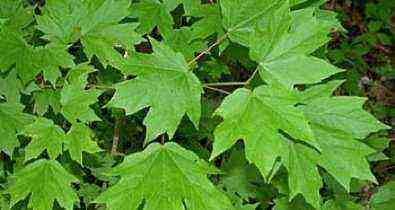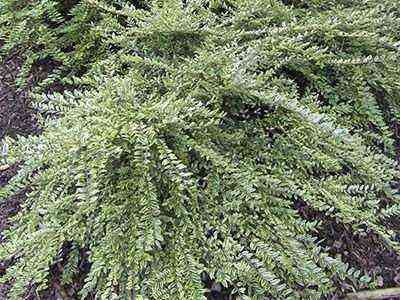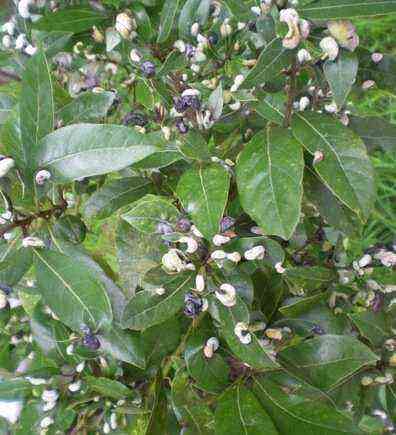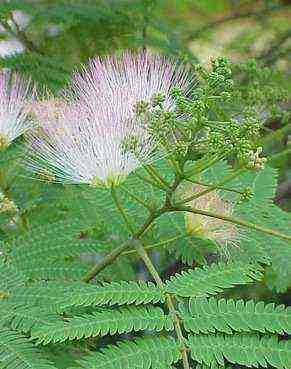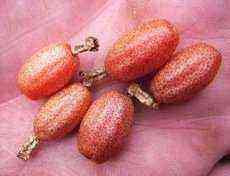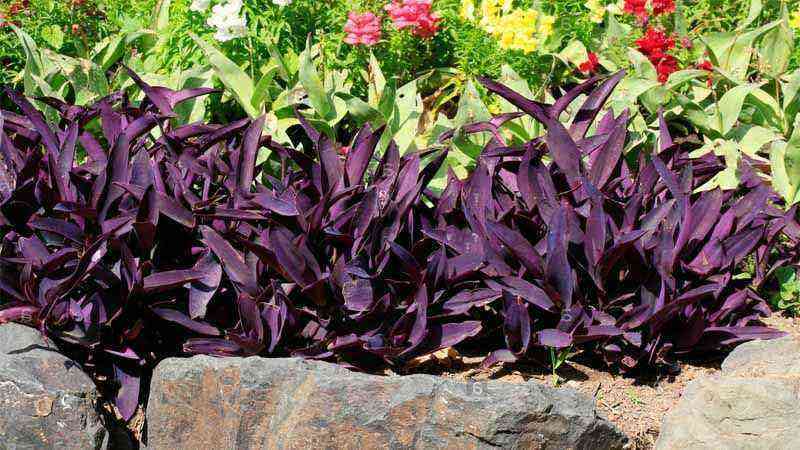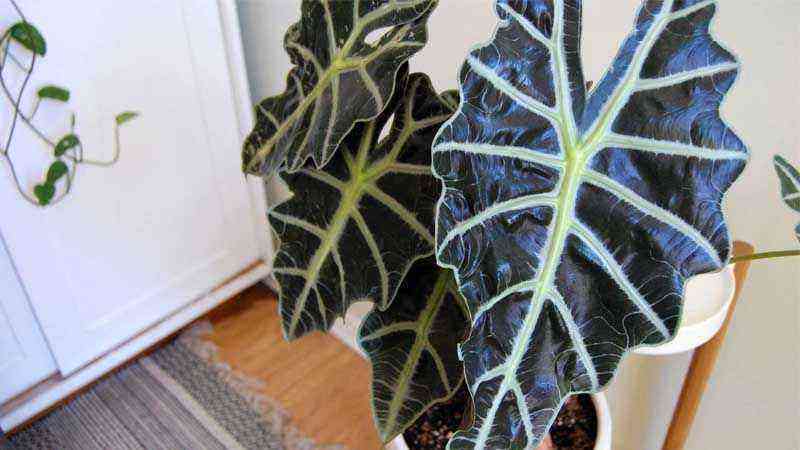It is worth setting aside a little time for proper care of this plant, and the florist will be rewarded with an incredible flowering of indoor jasmine.
Description
Jasmine (lat.Jasmínum) is a shrub that belongs to the genus Olive. It can be both curly and upright. The native land of the plant is the subtropics of Southeast Asia and Europe, as well as the Caucasus and Crimea. The white jasmine is recognized as the state flower of Pakistan, and the sambac jasmine is the emblem of the Philippines and Indonesia, where it is considered the main ceremonial wedding flower.
But the flower was loved not only for its beautiful flowers. Its leaves have a flawless oblong-oval shape with slightly pointed tips and sit on short cuttings in pairs. The jasmine flowers themselves are ordinary, but at the same time noble, divided into 6 petals. Inflorescences can be tubular, ordinary or double.
Most of the plants are found mainly in white or cream colors. Although you can often find species with pink and yellowish buds.
The flowering period of indoor jasmine is about 20 days in almost all species. It is worth noting the amazing ability of the plant petals to change their color and acquire a reddish color in the last days of flowering.
How to achieve flowering
To achieve a beautiful and fragrant flowering of a houseplant, a number of rules must be followed.
The first rule concerns the care of the plant in winter. During this period, the flower is transferred to a room with a temperature of + 10 … + 15 degrees, while from spring to autumn the temperature is increased to + 18 … + 24 degrees.
If you leave the plant in a very warm room in winter, that is, neglect the temperature regime, this will not affect its development. But the plant will not bloom at the same time. Also, a prerequisite for caring for a plant is frequent airing of the room where the flower is located, especially in winter.
Species and varieties
The species diversity of this flower is quite large. More than 190 species can be counted in total. Gardeners, most often, choose two or more types of jasmine for indoor cultivation. It is better to select those of them that have differences in flowering, but have a similar structure of the bushes.
Jasmine grandiflorum (Jasminum grandiflorum)
It is also called pharmaceutical. It looks like an evergreen vine covered with small leaves. The flowering period begins in spring and ends in autumn. Flowers – large, white, with a pronounced aroma.

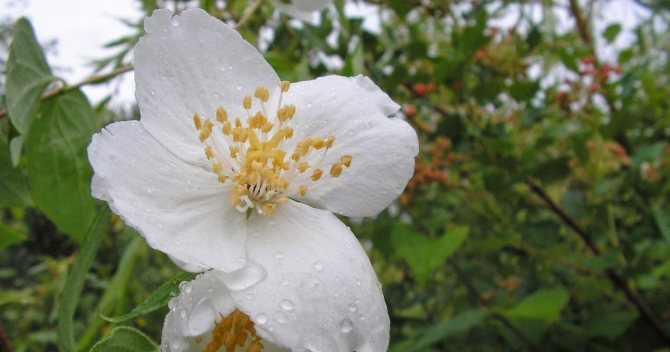
Jasmine multiflorous (Jasminum polyanthum)
During flowering, the plant is covered with a large number of flowers with a fairly strong odor. After full bloom, the pink buds become completely snow-white.


Jasmine (Jasminum nudiflorum)
The peculiarity of this species is the bright yellow flowers that cover the plant from December to April.

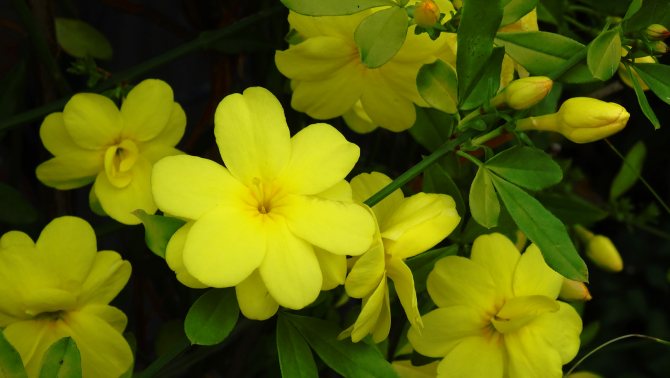
Jasminum sambac
The plant pleases with large double flowers of snow-white color, which gradually acquire a reddish color. However, this beauty quickly fades. Sometimes fragrant flowers can last less than a day on the plant.

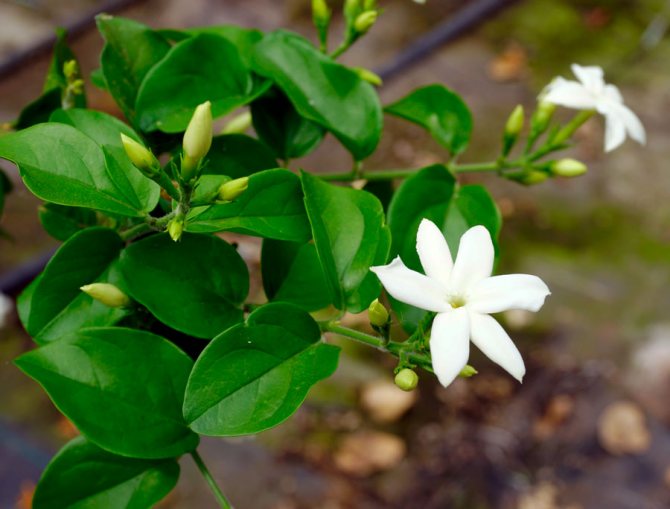
Jasmine primulinum (Jasminum primulinum) or Japanese Jasmine (Japanese Jasmine)
Differs in large yellow flowers with a complete lack of aroma. Moreover, the plant has flowers of an unusual shape. Somehow they resemble a primrose. The flowering period is the spring-summer season.
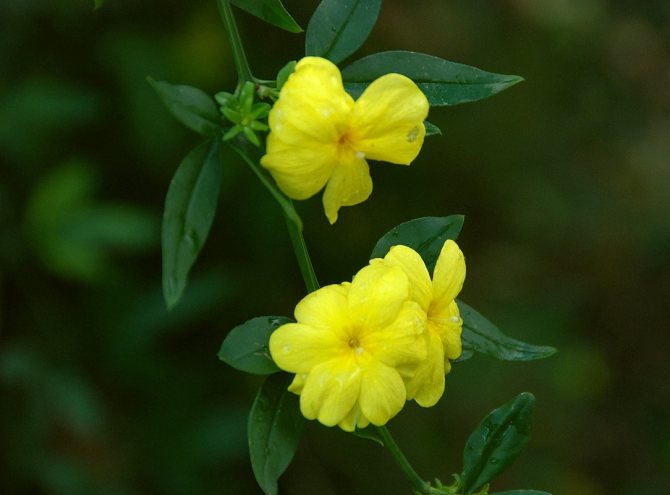

Jasmine Stephanotis flowering (Stephanotis floribunda)
This species is also called Madagascar jasmine. The plant looks like a climbing vine. Very often you can find this type of plant in houses and apartments. But you should be very careful, as its juice is very pungent. It causes severe irritation in case of contact with skin or eyes.
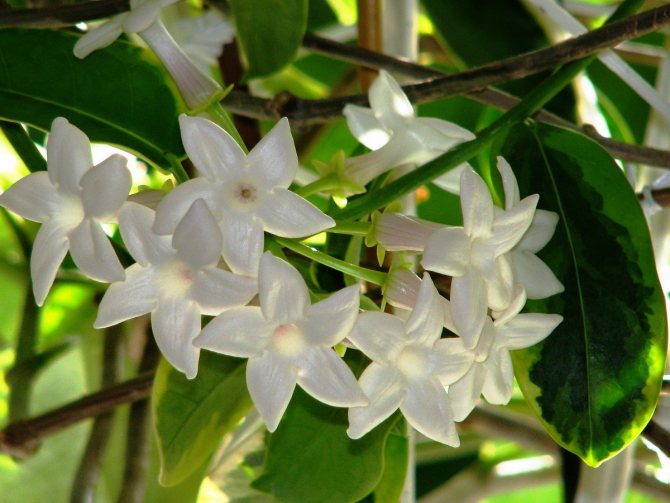
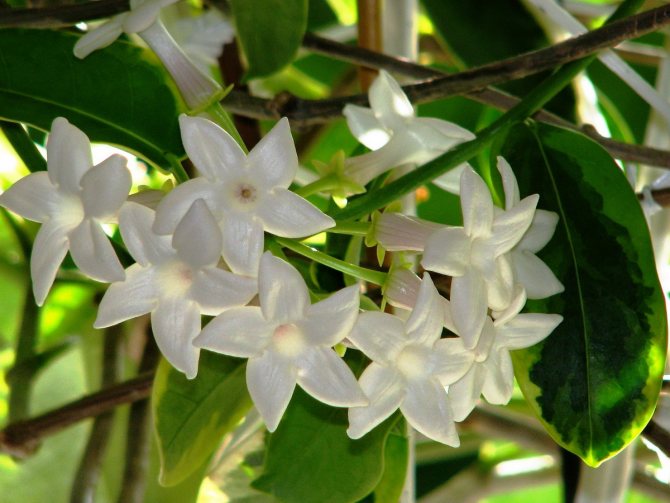
Types of indoor jasmine
Check out these articles as well
- Cabbage variety Kolobok F1
- Cherry Valley duck breed
- Grape variety Anyuta
- Winter chicken coop
There are more than 300 types of jasmine in nature, but not every one can be grown at home. So which species are suitable for indoor development?
Interesting!
Many types of indoor jasmine can be used to brew tea. In an apartment environment, large-flowered jasmine can be planted for these purposes.
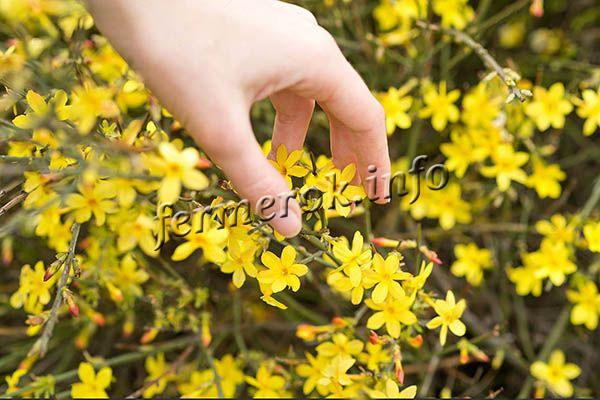
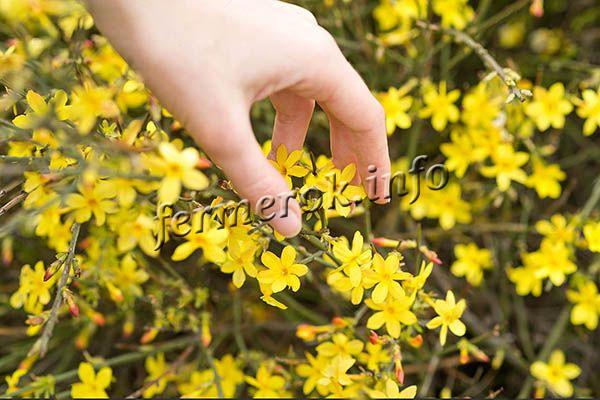
Photo of holo-flowered Jasmine (Jasminum nudiflorum)
- Indoor jasmine is a shrub. Shoots are long, leaves are small, green, trifoliate. Flowers are yellow, large, growing singly along the entire length of the pagon. Bloom is observed from January to April.
- Primrose – a type of home-grown jasmine, which is a vine. Grown only when supported. Flowers are yellow, semi-double, odorless. Flowering is observed from May to June.
- Stefanotis or Madagascar jasmine is a beautiful ornamental plant for growing in an apartment or house. It is poisonous, so it is important to keep it out of the reach of children and animals. Represents a vine. The leaves are dark green, oval. The flowers are white, cream, purple or yellow, in the form of stars, collected in inflorescences. The aroma is pleasant. Bloom is observed from June to August.
When choosing indoor jasmine, it is worth considering its flowering time, features of the development of culture, as well as many other nuances.
How to care
Despite the above, caring for indoor jasmine is not so problematic. You just need to adhere to the basic rules.
Soil selection
The ideal soil is a mixture that includes:
- sand – 1 part;
- leaf land – 2 parts;
- coniferous land -2 parts;
- peat – 2 parts.
The main condition is a neutral or slightly acidic soil environment.
However, jasmine is quite good in hydroponics without soil. This option has proven itself especially for home maintenance of jasmine.
Location and lighting
For a houseplant to feel comfortable, it needs a lot of diffused sunlight. It is very important that the flower is protected from direct sunlight, which will destroy the plant.
A southern window sill might be a good spot. However, in this case, it is necessary to use a film or a transparent cloth to diffuse the light.
The most inappropriate place to grow a flower is on the north side of the house. Under these conditions, the plant will grow very slowly and most likely will not bloom.
Jasmine is great for the western or eastern part of the building. The pot with the plant can also be exposed outdoors and provide diffused lighting conditions for it during the summer months.

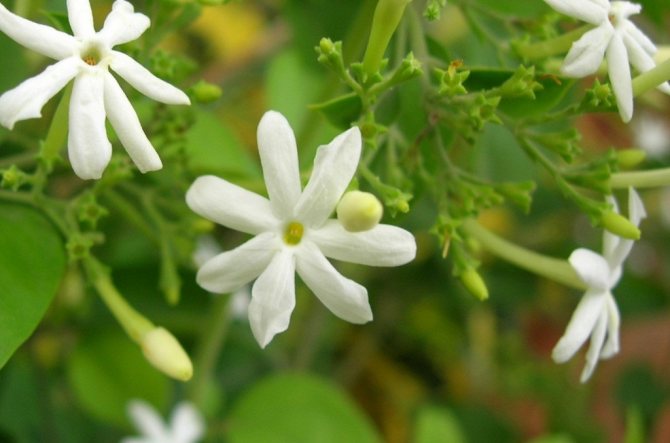
It should be borne in mind that when transferring a flower from a darker to a lighter place, it is necessary to create conditions for the gradual accustoming of jasmine to changing lighting. If this is not done, you may notice burns on the plant.
Temperature, humidity, watering
As mentioned above, in winter jasmine requires a temperature not higher than + 10 … + 15 degrees Celsius, and in summer + 18 … + 24 ° С. For watering plants, exclusively settled water is suitable, the temperature of which should be several degrees higher than the temperature of the room where the flower is located. The signal for watering jasmine is dry soil in a pot. Be careful not to let the soil dry out below the top layer.
In winter, the abundance of watering decreases. However, the ground should not dry out more than half.
Indoor jasmine loves humid air. It must be sprayed with the same water as for irrigation. Moistening jasmine from a spray bottle in winter is not allowed.
At the time of flowering, a pot with a plant is placed in abundantly moistened pebbles or expanded clay.
Fertilizers and fertilizing
Jasmine is treated alternately with organic and mineral fertilizers from May to September. Such processing is carried out twice a month. In the autumn, the frequency of this procedure is reduced to once. In winter, feeding is not carried out at all.


Transfer
Primary bushes are transplanted once a year. Adult plants are transplanted every three years.
The diameter of the new pot can be increased by no more than 2-3 centimeters. If you do not adhere to this rule, then the soil can acidify, and as a result, the jasmine will simply die.
Trimming
Flower growers prune jasmine in winter, before the plant begins to actively grow. Long stems are trimmed to about one third of their length. Dried underdeveloped branches are cut from the middle, otherwise they will interfere with the normal growth of jasmine.
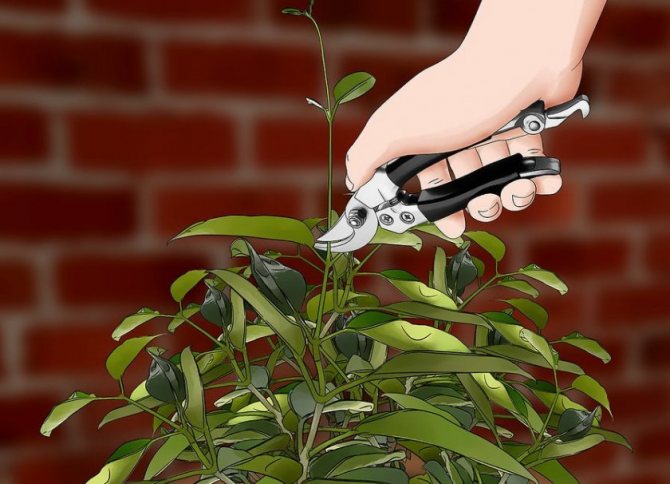
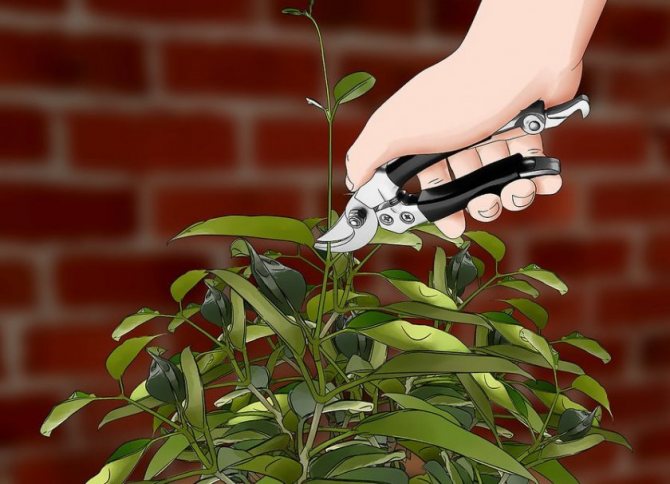
Remember that the main condition for the growth and development of a plant is precisely its correct pruning.
It is also recommended to tie the stems of an adult plant to a support. You can shoot a flower on a vertical surface.
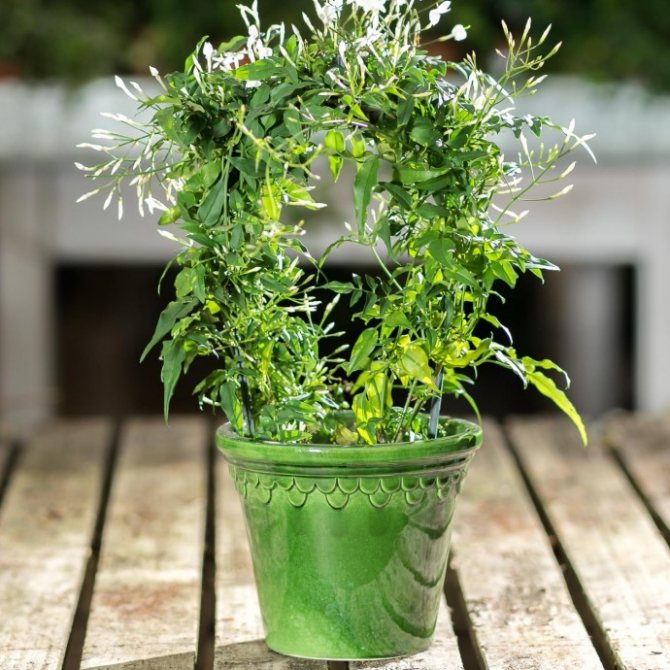
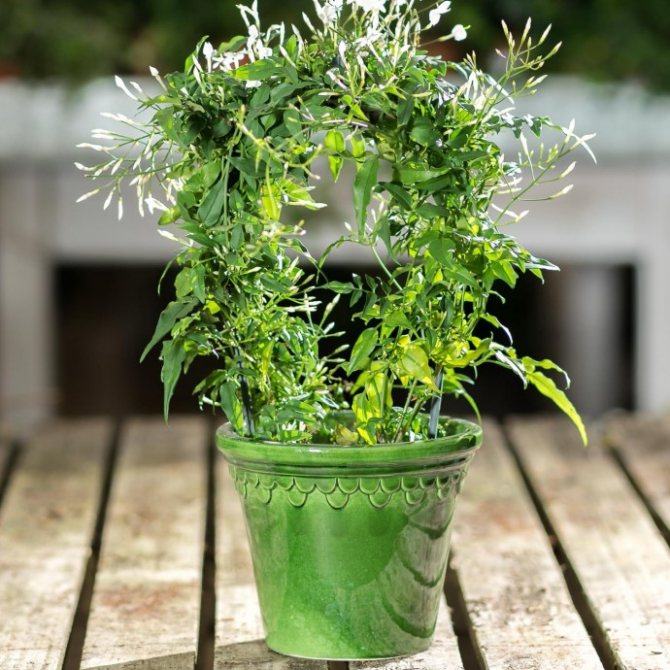
Winter care
It is important to remember that jasmine needs special care in winter. This will ensure good growth and flowering. After the onset of cold weather, the plant is winterized. To do this, he is transferred to a bright room. At the same time, the temperature in the room cannot exceed + 12 … + 16 degrees.
Home care
A strong, healthy indoor jasmine can only be grown if you provide it with full-fledged care at home.

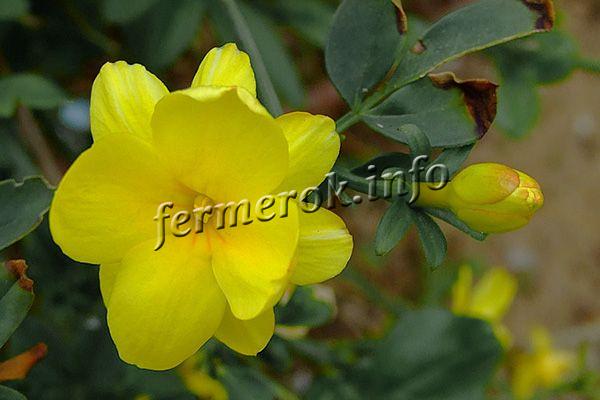
Photo of Primrose Jasmine
- Watering . The amount and amount of watering depends on the ambient temperature. When it is warm, watering is carried out every 3 days, and in the cold season, the introduction of water is reduced to 1 time in 1-3 weeks. You can navigate by the ground. When it dries out 1.5 cm deep, watering can be carried out. Water for irrigation should be used settled, warm.
Interesting!
To maintain the quality of the soil, you can take acidified water every 3 waterings. To do this, dissolve 1 teaspoon of apple cider vinegar in a liter of water.
- Feeding . So that the plant does not suffer from a lack of nutrition, it is necessary from April to August (and for the sambac variety – until the end of flowering), to feed with universal minerals for flowering plants. Best of all, indoor jasmine reacts to liquid minerals. In addition, organic can be used, but not often. And in order to prevent foliage from getting sick, foliar spraying is sometimes carried out.
- Trimming runs from February to March. It has a positive effect on jasmine (prolongs flowering, enhances growth), therefore it is recommended to carry out it. In addition to the formation of the crown, it is also important to cut off curved pagons that grow incorrectly, broken, damaged, diseased.
Only with high-quality care can a healthy jasmine be grown, which will delight not only with its decorative appearance, but also with regular flowering and a pleasant aroma.
Methods of reproduction
To obtain the offspring of indoor jasmine, two methods are used.
Cuttings
For cuttings in the spring, ripe stems are chosen, while in the summer it is worth giving preference to green shoots. Reproduction requires shoots that grow at the ends of the stems and have three internodes.
The following types of potting soil are used for planting cuttings:
- Earth and sand in equal parts.
- A layer of peat and river sand in equal parts.
In order for the cuttings to take root, the bottom of the pot must be heated. With the correct procedure, the cuttings take root in about 5-6 weeks. The rooted plant is then transplanted into small containers or pots.
For cuttings that have already taken root, a soil consisting of a ratio of peat, sand, turf and deciduous land in a ratio of 1: 1: 3: 2 is suitable. After the jasmine roots have completely encircled the pot, the cuttings are transferred by transfer to a pot with a diameter of 11 cm.
Air layering
To propagate a flower in this way, you need to place a small container filled with earth next to the mother plant. A small incision is made on the lower stem of an adult jasmine. It is important to carry out the procedure with a sterile knife. Next, the place of the incision must be pressed to the ground and fixed with a hairpin in a small pot. It will be possible to finally separate the layers from the mother plant after it gives the first young shoots.
Correct disembarkation process
For the best growth of jasmine, it is necessary not only to carefully treat the selection of soil, but also directly to the planting process itself.


The photo shows a step-by-step procedure for its correct disembarkation:
- Although the shrub can thrive on any soil, it is best to opt for soil that contains nutrients.
- Since the roots respond negatively to excess moisture, it is supposed to choose that piece of land that is located on a small elevation.
- Then it is necessary to pour sand into the hole, combined with small pebbles. This layer will play the role of drainage. In the spring, you can add 40 g of nitrophosphate to the hole so that the plant takes over sooner.
- After planting a bush and compacting the soil, the plant is watered.
Possible problems
If the air in a room with jasmine is not humid enough or irrigation is carried out with inappropriate water, jasmine leaves can curl, dry out and fall off.
The same problem occurs if the flower is in direct sunlight. To solve this problem, the bush is simply rearranged in a darker place. The foliage must be regularly moistened with a sprayer (this method is not applicable during flowering).
If the water for jasmine is not properly prepared, the shoots will begin to dry out.
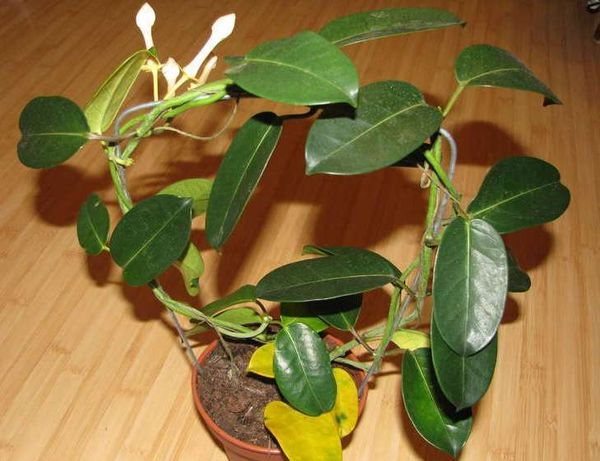

Jasmine in landscape design
Fragrant and pliable for a haircut, jasmine is indispensable as a hedge. Low-growing varieties are successfully embedded in rockeries, alpine slides and rabatki. Also, jasmine looks great by the reservoirs, picturesquely reflected in the water.


Hydrangea and spiraea coexist well with jasmine. From climbing plants with garden jasmine, clematis, actinidia, climbing roses are combined.

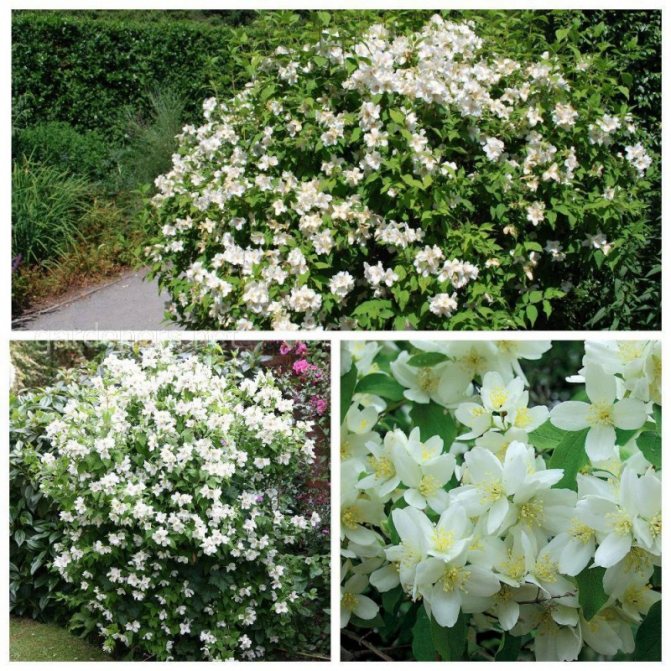
Diseases and pests
Jasmine, like other residents of the home windowsill, is susceptible to pests that can threaten its life.
The most common parasites are spider mites, scale insects, aphids, mealybugs and whiteflies. If insects are found on a flower, growers need to start a fight with them, namely: remove damaged shoots and treat untouched areas with soapy water.
If simple methods of plant protection do not help, the gardener will have to use heavy artillery, more precisely, insecticides.


Medicinal properties and contraindications
Jasmine is a very healthy plant. Its leaves are useful for stopping lactation and also as an antipyretic.
Hot compresses are also made from a houseplant. They are great for treating skin ulcers.
The untreated root of this indoor miracle can also be used as a pain reliever to relieve a patient’s fracture and migraine headaches. Such a remedy will also help to cope with insomnia.
It is important to understand that jasmine-based products can only be used after consulting a specialist.


During the flowering period, jasmine must be taken out of the bedroom at night, since the smell of the flower can lead to severe headaches and nausea.
Having provided a wonderful indoor flower with proper care, the florist will enjoy its beauty and grace for many years.
